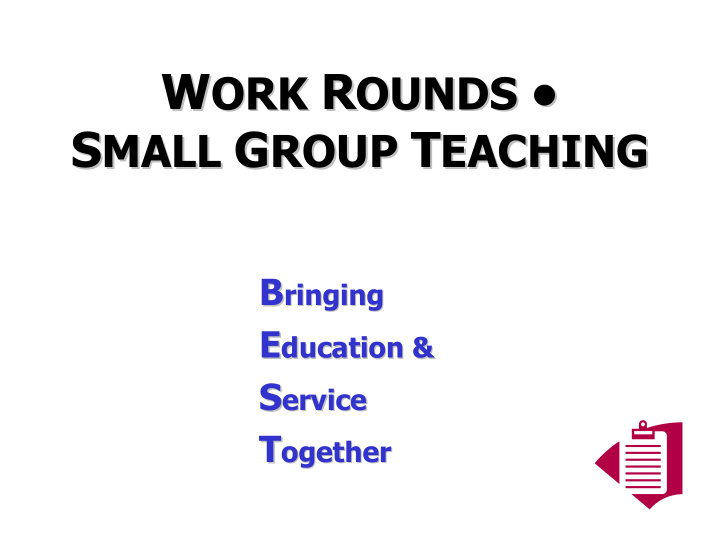



W ORK R OUNDS W ORK R OUNDS • • S MALL G ROUP T EACHING S MALL G ROUP T EACHING B ringing B ringing E ducation & E ducation & S ervice S ervice T ogether T ogether
Learning Objective Learning Objective After participating in this session, participating residents will be able to lead inpatient work rounds, incorporating teaching appropriate to each learner’s level of training.
Small Group Teaching Small Group Teaching May include: • Inpatient rounds • Other small-group settings – Problem-based learning sessions – Ambulatory rounds – Other groups
Challenges Challenges • Challenges of small-group teaching: – Teacher must facilitate learning for multiple learners at once. – These learners may be from different training levels or from different disciplines. • The senior resident can take the lead even if the attending physician is present.
The “LMNOPQRST” The “LMNOPQRST” Approach to Work Rounds Approach to Work Rounds Learners Questions L Microskills Recall M Needs Synthesis N Organization Teaching O Presentation P
L EARNERS L EARNERS • Who are all your learners for this small-group discussion? • Help create a positive learning climate by ensuring that everyone in the group knows each member’s name, discipline and training level.
M ICROSKILLS M ICROSKILLS • Teach through questioning. • The “five microskills” model works in group teaching as well as in one-to-one precepting. • Make sure each team member participates in the discussion.
N EEDS N EEDS • Briefly establish learning goals for rounds, starting with the learners. • Is there anything they especially want to learn today? • What are your goals for them?
O RGANIZATION O RGANIZATION • How can you best organize rounds during the time you have? • Take into account: • The number of patients to present • Other scheduling factors (clinics, etc.) • Learning needs of the team • “Teachable moments”
P RESENTATION P RESENTATION • When learners present, have team listen without interruption. • Set guidelines for presentations: • Level of detail for new patients • Ongoing patients : one-sentence case summary, overnight progress, problem list review with today’s plans
Q UESTIONS Q UESTIONS • Use the five “microskills” to maximize teachable moments: 1. Get a commitment 2. Probe for supporting evidence 3. Teach general rules 4. Reinforce what was done right 5. Correct mistakes
R ECALL R ECALL • Lower-order questions test learners’ recall of factual information . • Example: “What is Murphy’s sign?”
S YNTHESIS S YNTHESIS • Higher-order questions test learners’ ability to synthesize and analyze information . • Example: “Given these physical findings, how would we now alter our differential diagnosis?” • Try to incorporate these “thinking questions” into the discussion.
T EACHING T EACHING • Discuss resources for the team’s further learning: • Articles (which you can even bring in) • Online resources • Texts • Tailor your recommendations to learners’ individual training.
Recommend
More recommend